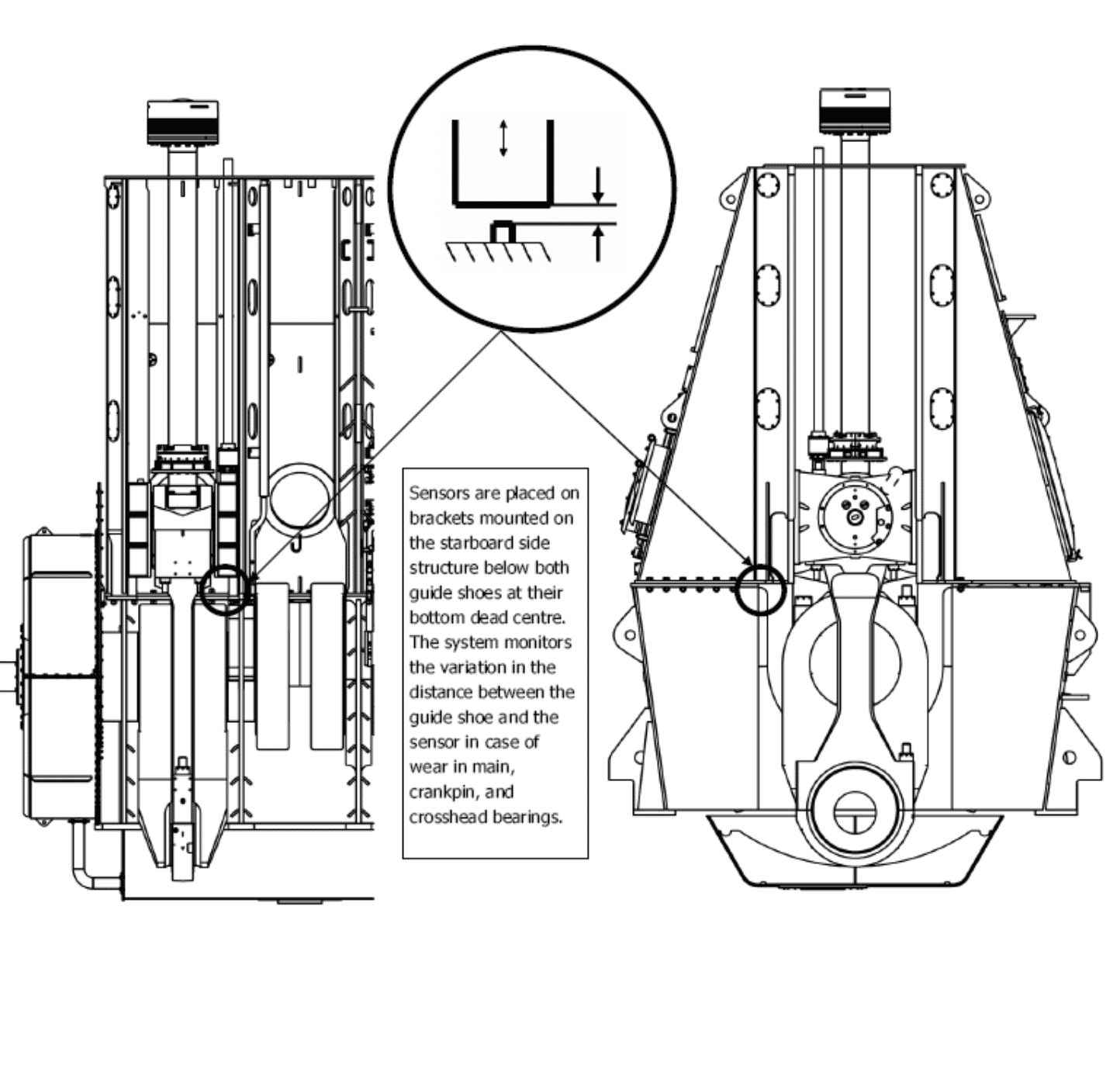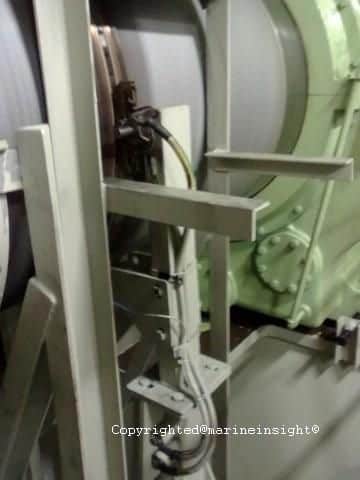Different Ways to Monitor Bearing Condition and Reduce Bearing Breakdown in Modern Marine Engines On Ships
The bearings of modern marine engines come with high load carrying capacity and good alloys combination (Sn, Al, Pb etc.), which provide excellent embedding and sliding properties. The ship engineers should know the operating hours of various bearings inside the engine and also plan checks and overhauling procedures accordingly.
It has often been seen that the bearing failure or breakdown occurred well ahead of the running hours. The cost of bearings vary depending upon it’s position. If any major damage or breakdown occurs, the total costing involved increases, as the journal pin of the shaft or of the crank web has high chances of getting damaged. In case of severe bearing damages, the engine bedplate can also get damage. Needless to say, any major repair on the main engine crankshaft or bedplate may cost thousands of dollars.
To avoid such breakdown and minimise costs, various monitoring system can be fitted along with following best practices, to ensure that the bearings complete their running hours without giving any trouble.
Advantage of having a Monitoring System for Marine Engine Bearings:
- Alarms the ship engineer well ahead of steel to steel contact situation (maximum damage occurs at this level)
- Easy to install and can be done on retrofit system
- Inexpensive to install and maintain
- It senses and provides continuous condition based data for easy monitoring
- Decreases the schedule open up inspection and hence man hours
- Removes the possibility of contamination of Internal parts and sump oil when opened up for inspection
- The engine maker will cut down the manual monitoring (deflection, clearance measurements, etc.) if such systems are applied and approved by them
The bearings of a marine engine can be said is wearing down when:
- The lining (Babbitt or Tin-Aluminium) is worn away by lining scuffing
- Wiping of linings due to excessive loading
- Abrasive wear due to contamination of lube oil
- Melting out or extensive fatigue of the lining (Babbitt) due to lack in supply of oil or high temperature of the bearing
- When steel to steel contact occurs
Following are the different ways to safeguard and monitor the main engine bearings:
Manual monitoring methods:
- Crankcase inspection
- Crankshaft Deflection
Electronic monitoring methods:
- Bearing Wear Monitoring (BWM)
- Bearing Temperature Monitoring (BTM)
- Water in Oil Monitoring (WIOM)
- Propeller Shaft Earthing Device
The main aim of the BWM, BTM and WIOM systems is to prevent major bearing damage well ahead of time. This system, however cannot protect the bearing shells but mainly avoid consequential damage of the crankshaft and bedplate in case of severe bearing failures.
The Propeller Shaft Earthing Device however is designed and installed to protect the bearing from spark erosion.
Crankcase inspection:
Crankcase inspection is modelled plan for engineers on ship under the Planned Maintenance System (PMS) to inspection the main engine crankcase space and bearings set up for any abnormality.
Crankshaft Deflection:
The Crankshaft deflection is a procedure to measure the misalignment of the shaft at various levels when compared to the original/last reading of the measured deflection. Normally, this procedure is performed with crankcase inspection. The recorded readings are then interpreted in a graph and compared to the original graph to point out the worn- out or defective bearings which are causing crankshaft misalignment.
Read More :
Bearing Wear Monitoring :
The principle of the Bearing Wear Monitoring (BWM) system is to measure the vertical position of the crosshead in bottom dead centre (BDC).
The general BWM system monitors all three principle crank train bearings using two proximity sensors forward and aft per cylinder unit, placed inside the frame box. The sensor continuously monitors the guide shoe bottom ends and measures the distance to the crosshead in BDC.

These sensors send the continuously monitored data to an alarm system in the ship’s computer monitoring system. Hence, when there is a notable wear in the main, crankpin or in crosshead bearing, this monitored vertical position will shift and the same will be reflected in the monitoring system of the ship. If this shift reaches the set alarm values for one or more unit, the engineer will be alerted about the situation. This monitoring system is connected to the safety system of the engine which might slow down the engine when the Bearing wear alarms occurs.
Bearing Temperature Monitoring :
The rise in temperature can be considered as an important sign of an abnormality in the engine bearings. If the temperature of the bearing can be monitored and taken into account before it rises to dangerous level, major breakdown of engine crankshaft and bearing arrangement can be prevented. The measurement of bearing temperature can be done by two ways:
Direct Measurement: Using temperature sensors normally fitted at the rear side of the bearing shell
Indirect Measurement: Detecting the temperature of return oil from each bearing in the crankcase

Temperature monitoring system continuously monitors the temperature of the bearings. In case a specified temperature is recorded, either a bearing shell temperature or bearing oil outlet temperature, an alarm is raised. For shell temperature in main, crankpin and crosshead bearings two high-temperature alarm levels apply.
The first level alarm is indicated in the alarm panel while the second level activates a slow down command. For oil outlet temperature in main, crankpin and crosshead bearings two high temperature alarm levels including deviation alarm apply. The first level of the high temperature/deviation alarm is indicated in the alarm panel while the second level activates a slow down command.
Water in Oil Monitoring :
The Water content in the lubricating oil is a crucial factor for maintaining good bearing condition in the main engine. A significant increase in the water content (typically max. 0.2 vol.%; for a short period up to 0.5 vol.%) can extremely damage engine bearings. The increase in water content will have the following effects in different bearings:
- Excessive water content will cause the lead overlay, which acts as a running layer, in crosshead bearings (Tin-Aluminium lined) to corrode away
- Main and crankpin bearings lined with Babbitt or Tin- Aluminium may also suffer irreparable damage from water contamination
These damages can be prevented if the lubricating oil of the engine can be continuously monitored for water contamination.
Two methods can be used for monitoring water contamination:
Manual: By checking the water contamination bi weekly using water in oil test kit provided by the marine engine makers. The major disadvantage of this method is the time gap and discontinuity in the monitoring of water content.
Automatic: By installing a Water In Oil Monitoring System in the engine lube oil system, which will continuously measure the relative humidity in the system oil. A probe in the oil piping system is installed which transmits the signal to a unit intended to calculate the humidity as Water Activity. The major advantage of such system is the continuity in monitoring the water content in oil for early troubleshooting and addition to that, this system is being independent of oil type, temperature or age. The system is connected to the alarm system which will activate an alarm if the water content reaches the set value.
Propeller Shaft Earthing Device
In a vessel, different metals are used to build propeller, hull, bedplate, crankshaft, bearing etc. The current from the cathodic protection system is generally present in these parts, which eventually creates the perfect situation for spark erosion. When two current carrying dissimilar metals are in contact, a sparks travels at the point of contact, which erodes the small metal by making a cavity.
To suppress the effect of galvanic corrosion, especially at the stern part of the ship where the propeller is present, an Impressed Current Cathodic Protection system is used. The propeller shafting is earthed to achieve continuous circuit and to avoid malfunction of the same.
This circuit usually exists when the propeller is at a rest, where a metal to metal contact is made between the shaft and the stern tube liners, or main engine bearings and journals.
However, whilst the shaft is turning the bearing oil film creates an intermittent high resistance which effectively insulates the propeller from the hull structure.
Disclaimer: The authors’ views expressed in this article do not necessarily reflect the views of Marine Insight. Data and charts, if used, in the article have been sourced from available information and have not been authenticated by any statutory authority. The author and Marine Insight do not claim it to be accurate nor accept any responsibility for the same. The views constitute only the opinions and do not constitute any guidelines or recommendation on any course of action to be followed by the reader.
The article or images cannot be reproduced, copied, shared or used in any form without the permission of the author and Marine Insight.
Do you have info to share with us ? Suggest a correction
Subscribe To Our Newsletters
By subscribing, you agree to our Privacy Policy and may receive occasional deal communications; you can unsubscribe anytime.
Web Stories

About Author
An ardent sailor and a techie, Anish Wankhede has voyaged on a number of ships as a marine engineer officer. He loves multitasking, networking, and troubleshooting. He is the one behind the unique creativity and aesthetics at Marine Insight.













